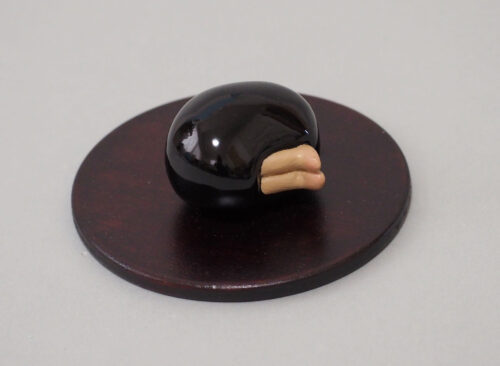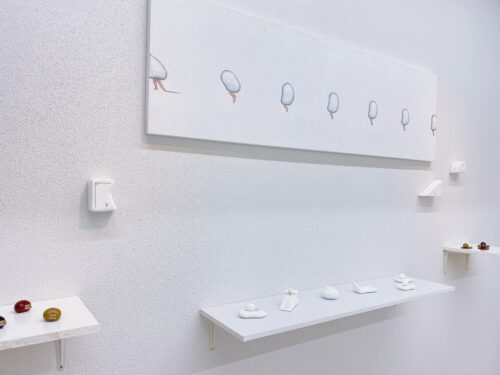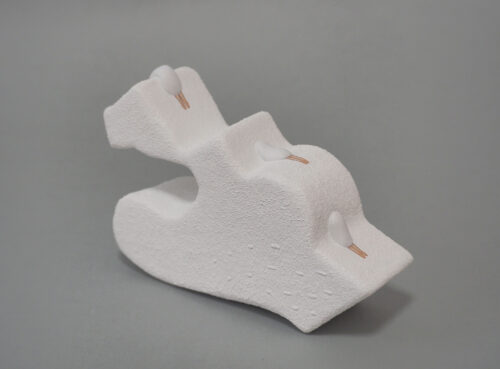Ginza is one of the major centers for contemporary art in Japan and Asia. It has been famous for selling works by established and well-known artists such as Yayoi Kusama or Yoshitomo Nara, but recently there has been a movement to discover talented young artists. Although Japan has produced many excellent contemporary artists, society considers contemporary art to be difficult to understand, so the general public does not often enjoy contemporary art daily. With the advent of social networking sites such as Instagram, artists and galleries are now actively communicating their works to the public, and young Asian art fans, who have become wealthy through IT business, are seeking out the works of artists before they become famous.
Ginza is the most expensive commercial district in Tokyo, Japan, and is a high-status area with many famous brand stores. Even when I was a staff culture reporter for a famous Japanese newspaper, it took a lot of courage to visit a gallery in Ginza. The small, tasteful spaces, the intellectual gallerists, the heavy silence… But times has changed. In this July 2021, Kanako Ozawa, who specializes in three-dimensional works and paintings that evoke the movement of animation, held a solo exhibition, Breath in Silence, at TomuraLee Gallery. Both the artist and the gallery had a relaxed atmosphere.
Ozawa was born in 1988 and graduated from the department of media art, Tokyo Polytechnic University in 2010. She has exhibited at Korea International Art Fair, Affordable Art fair in Milan, and Art Fair Tokyo.
Ozawa is very popular among the young and high-income people in Taiwan. She expresses the traditional Japanese beauty of “blank space” in a pure white space. The two-legged object reminds the audience of some kind of personification, and the viewer can feel the story in their own way.
Ozawa’s paintings appear to be still, but if you look closely, you can see movements. The characters she draws appear to be asleep, but in fact they are awake. Ozawa’s paintings are always in motion, like the animation technique of connecting scenes to create movement. The simple composition and wide pure white margins allow the audience to overlap their own reality.
Ozawa said, “I cherish something Japanese in myself. I expressed the Japanese animism that all things have a soul. When I go to a shrine, even if it is unmanned, I feel that there is something there. The movement of the wind, a small god. In order to let these things, dwell, I created a blank space. Although it is pop, it expresses the beauty of Japanese margins, which is like Zen. I hope people will enjoy the unique Japanese way of using margins.”
Ozawa’s images are rather concrete, and she is very particular about titles. “The path of the cat”-by placing three two-legged characters in a staircase pattern, this work gives the feeling of the movement of a small god-like creature. “Well…what is your name? ” -a lacquer-coated figurine. Ozawa apprenticed herself to a lacquer workshop to learn the technique. However, unlike the very precise Japanese craftsmanship, this work is open and relaxed, as if a child had freely applied crayons. Japanese earthenware from the Jomon period, a period that lasted for about 10,000 years, from about 13,000 years ago to about 2,300 years ago, also used lacquer, some earthenware excavated with lacquer on them. Ozawa says, “I used lacquer, which lasts a long time, in the hope that my work will remain after my death, and that my work will remain in the future.” “A child of mountain” -two legs of this work make audience feel like, “Is this something like a human being as me?” The legs make the audience feel closer to the artist and expand their image. “In a Dandelion stalk” -a scene was cut out of a moving story. The audience can create their own story from this work. Ozawa’s collectors often tell her, “I made up my own story when I saw your work via Instagram!” Art fans in Japan have been faithful to the instructions of critics, but young art fans are freer.
While high income people in Europe and the U.S. tend to prefer large, colorful works that they can look at every day and feel energized, young IT rich in Asia tend to prefer works that “fit in” with their homes.
In Ginza, galleries such as Gallery TSUBAKI, nichido contemporary art, and FUMA Contemporary Tokyo are becoming more active in discovering and introducing young talented artists who are pop, and who also have strong concepts and skills. While the old Japanese art fans tended to buy famous artists’ works that “everyone says are good,” now some young art fans buy young artists’ works before they become famous.
Japanese art critiques are generally aimed at specialists and often contain esoteric content. Now both artists and galleries are actively communicating through Twitter or Instagram in simple language and expressions, it helps to attract a wider range of art fans. The emergence of Art Fair Tokyo has also contributed to the rapid progress of young contemporary artists in Japan. Since 2005, it has been one of the largest international art fairs in Japan, showcasing a wide range of artworks from antiques and crafts to Japanese painting, modern art, and contemporary art. Art Fair Tokyo, as an art market platform that connects the East and the West, the present and the past, the fair is popular among young art collectors in Japan and Asia, and this March was also a great success even though amidst COVID-19. Ginza, once dominated by antiques and big-name contemporary artists, is now evolving.



